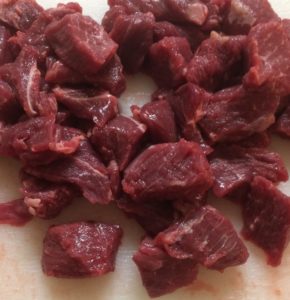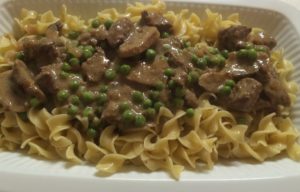There has been a bag of Amish Noodles staring at me from the pantry for a month. In July, my daughter and I traveled to my home state of Missouri, the northwestern corner of the state up by Kansas, where Mennonite & Amish Markets abound. There I bought a bulk bag of Egg Noodles with dreams of Beef Stroganoff.

One of our big sellers is Beef for Stew. I use it for many things soups, stews, kebabs, etc. This meal is larger, feeding up to 8 people (Or my just my ravenous bunch of kids – Editor/Farmer).
Boneless Beef for stew runs $8.99 per pound with all of the ingredients listed you’ll have dinner for roughly $12-$15. If you want to jazz it up a bit use one of our Sirloin Steaks at $14.99 lb, thinly sliced with the fat removed.
Beef Stroganoff
- 1 lb NCF Beef for stew
- 2 tbsp Butter (extra virgin olive oil can be substituted)
- 1 med yellow onion sliced thinly
- 3 cloves of garlic minced
- 8 oz Cremini mushrooms

- 1 cup beef broth (low sodium or no salt)
- 1 cup Guinness beer or 1 cup Pinot Noir (if you prefer no alcohol double the beef broth)
- 2 tbsp Worcestershire sauce
- 1 tbsp Dijon mustard
- 1 cup sour cream
- 1 cup fresh peas *optional
- salt & pepper to taste
- The Beef for Stew chunks are rather large. The first step is to cut them down to bite size removing any left over silver skin, season with salt and pepper.
- Melt the butter in a large deep casserole or dutch oven over med heat.
- Once the butter has melted add in the onions & mushrooms lightly salt, cook until the onions are translucent with a bit of browning showing.
- Add seasoned beef and cook till browned.
- Toss in the garlic and cook until fragrant, about 1 minute.
- Next up add the broth, Worcestershire sauce, Dijon mustard and the beer.
- Lower the heat to med low.
- Place lid on and simmer for 45 min to 1 hour stirring frequently if the liquid is greatly reduced add a bit more broth.
- If adding in peas do so now, let cook for 4 minutes.
- Add in sour cream
- Taste adjust salt and pepper.
- Serve over warm egg noodles.

Noodle Prep
- 2 cups Extra Wide Egg Noodles
- 1/2 tsp Nutmeg
- 1 1/2 tbsp Butter
- Prepare Egg Noodles per instruction on bag.
- Drain
- Finish with butter and Nutmeg